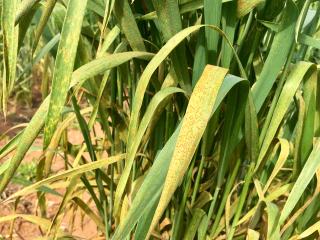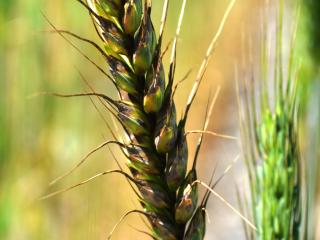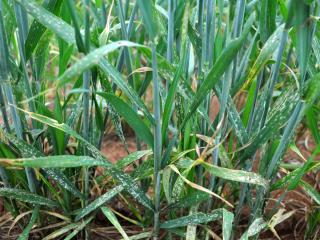Wheat disease update
Leaf rust
- Woorree, Geraldton
Plant pathologist Ciara Beard (DPIRD) has reported finding leaf rust (WLR) on an unnamed wheat variety in pre-breeding plots at the DPIRD trial site at Woorree, Geraldton. The plant’s flag leaf is fully emerged and the canopy is covered in leaf rust.
When checking crops growers and consultants are also urged to look into the bottom of the canopy and stems for the presence of stem rust.
If WLR is found, growers and consultants are strongly urged to participate in the Australian cereal rust survey and submit samples to the University of Sydney, Private Bag 4011, Narellan, NSW 2567 for pathotype testing.
Apply a registered foliar fungicide prior to crop flowering on susceptible-intermediate varieties showing wheat leaf rust symptoms. Previous DPIRD trials have shown that the chance of an economic benefit from the use of fungicides to control leaf rust after the commencement of flowering will be far less than earlier timed applications. The only exception is in susceptible wheat varieties.
As the season progresses and warmer drier conditions occur, the likelihood of an economic response to fungicide will diminish. Spraying decisions should bear in mind the level of disease in the crop, the varietal susceptibility, the time of the season and growth stage of the crop plus the chance of ongoing rainfall after spraying being favourable for disease development.
For more information on diagnosing and managing this disease refer to DPIRD’s Diagnosing leaf rust of wheat and Managing stripe rust and leaf rust in wheat in Western Australia pages.
Glume blotch
- Woorree, Geraldton
Plant pathologist Ciara Beard (DPIRD) has found glume blotch caused by the pathogen Stagonospora nodorum (also now known as Phaeosphaeria nodorum) in Zippy wheat at Woorree, Geraldton. The crop is at grain fill and the disease has worked its way up from the leaves.
Glume blotch is best prevented by application of a registered fungicide when the grain ear is half emerged (GS 55) and when the disease is seen moving up the leaves, but most crops in the north are well beyond this growth stage now.
Further information about this disease can be found at DPIRD’s Managing yellow spot and septoria nodorum blotch in wheat page.
Powdery mildew
- Dandaragan
- Coomalbidgup
- Dalyup
- Gibson
David Cameron (Farmanco) has reported finding powdery mildew (PM) in Scepter wheat near Dandaragan. The crop is at late stem elongation (GS 39) and the paddock was sown to lupins in 2017.
Plant pathologist Andrea Hills (DPIRD) has reported that PM is being found at low levels in Scepter wheat crops at Coomalbidgup, Dalyup and at the DPIRD research station at Gibson.
The wheat variety Scepter is susceptible to very susceptible (SVS) to PM.
Growers and consultants can expect to see more powdery mildew as the temperatures increase and if humid and damp conditions continue.
It is crucial to control the disease before it becomes too severe and develops in the upper canopy and on heads, as then it is very difficult to control. A registered foliar fungicide can reduce the disease impact, but growers need to consider the weather outlook, variety susceptibility, growth stage and crop yield potential when deciding whether an economic response to fungicide application is likely.
If wheat powdery mildew is present and increasing in the canopy and the weather outlook is favorable (humid and mild), it is recommended that growers intervene with a well-timed application of registered foliar fungicide in susceptible varieties to stop disease reaching damaging levels and moving onto the flag leaf and head.
For more information on diagnosing and managing this disease refer to DPIRD’s Managing powdery mildew in wheat page.
Foliar fungicides
Growers and consultants that are considering applying a fungicide to manage diseases in wheat crops can find relevant information at DPIRD’s Registered foliar fungicides for cereals in Western Australia page.
For more information on wheat diseases contact Kithsiri Jayasena, Plant Pathologist, Albany on +61 (0)8 9892 8477, Geoff Thomas, Plant Pathologist, South Perth on +61 (0)8 9368 3262 or Andrea Hills, Plant Pathologist, Esperance on +61 (0)8 9083 1144 or Ciara Beard, Plant Pathologist, Geraldton on +61 (0)8 9956 8504.



